The Spring 2025 Undergraduate Research Symposium, hosted on May 16, gave students a chance to share their own research with the NYU Shanghai community. Students presented their work in three categories: Humanities & Social Science, Business & Economics, and STEM. The semi-annual event highlights the emphasis NYU Shanghai places on supporting student research and student-faculty research collaboration.
The research was evaluated by a committee of professors. Assistant Professor of Global China Studies Ka Lee Wong, one of the judges, praised the presentations. “The students’ research demonstrated their hard work, creativity and intellectual rigor,” she said. Another one of the judges, Associate Professor of Practice in Data Science Guo Li, who attended the symposium, said she was inspired by the students’ potential. “It was impressive to witness the technical depth, originality, and confidence demonstrated in our students' work,” she said. “Their ability to tackle complex problems and communicate their ideas effectively reflects the excellent academic environment at NYU Shanghai.”
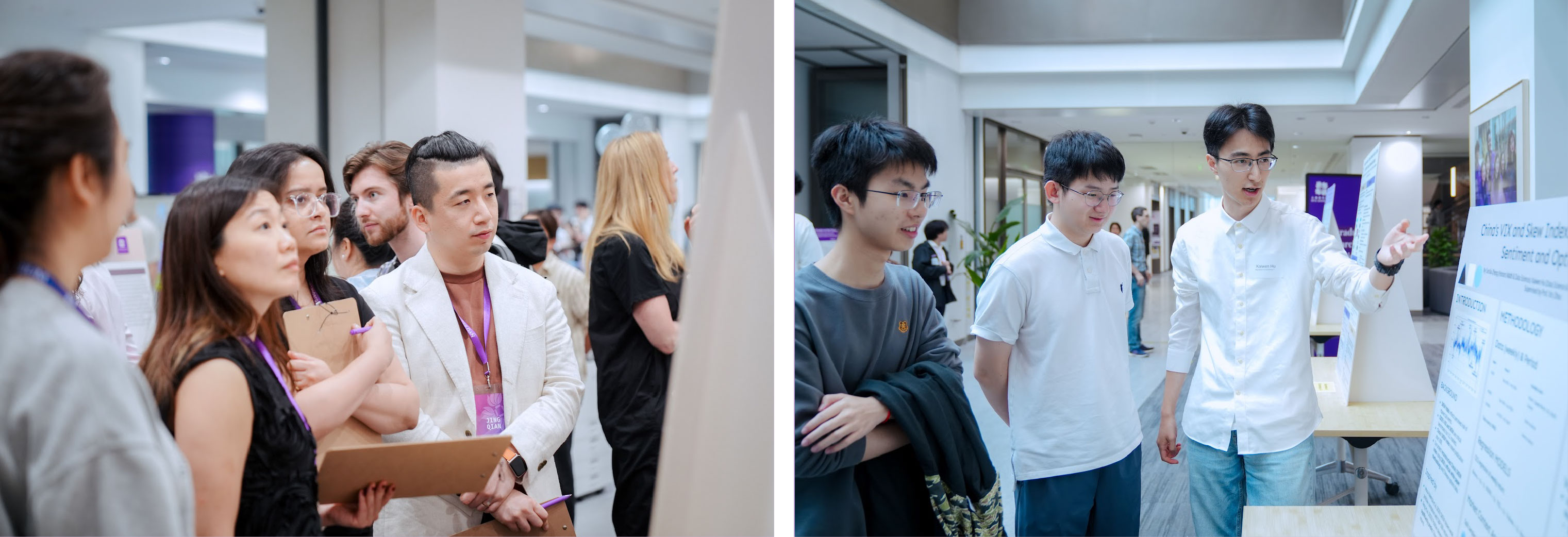
Below are the winners for Best Research Project and Best Presentation in Business & Economics, Humanities & Social Science, and STEM, as well as Most Popular Project, as voted by attendees of the symposium.
Business & Economics
Best Research Project
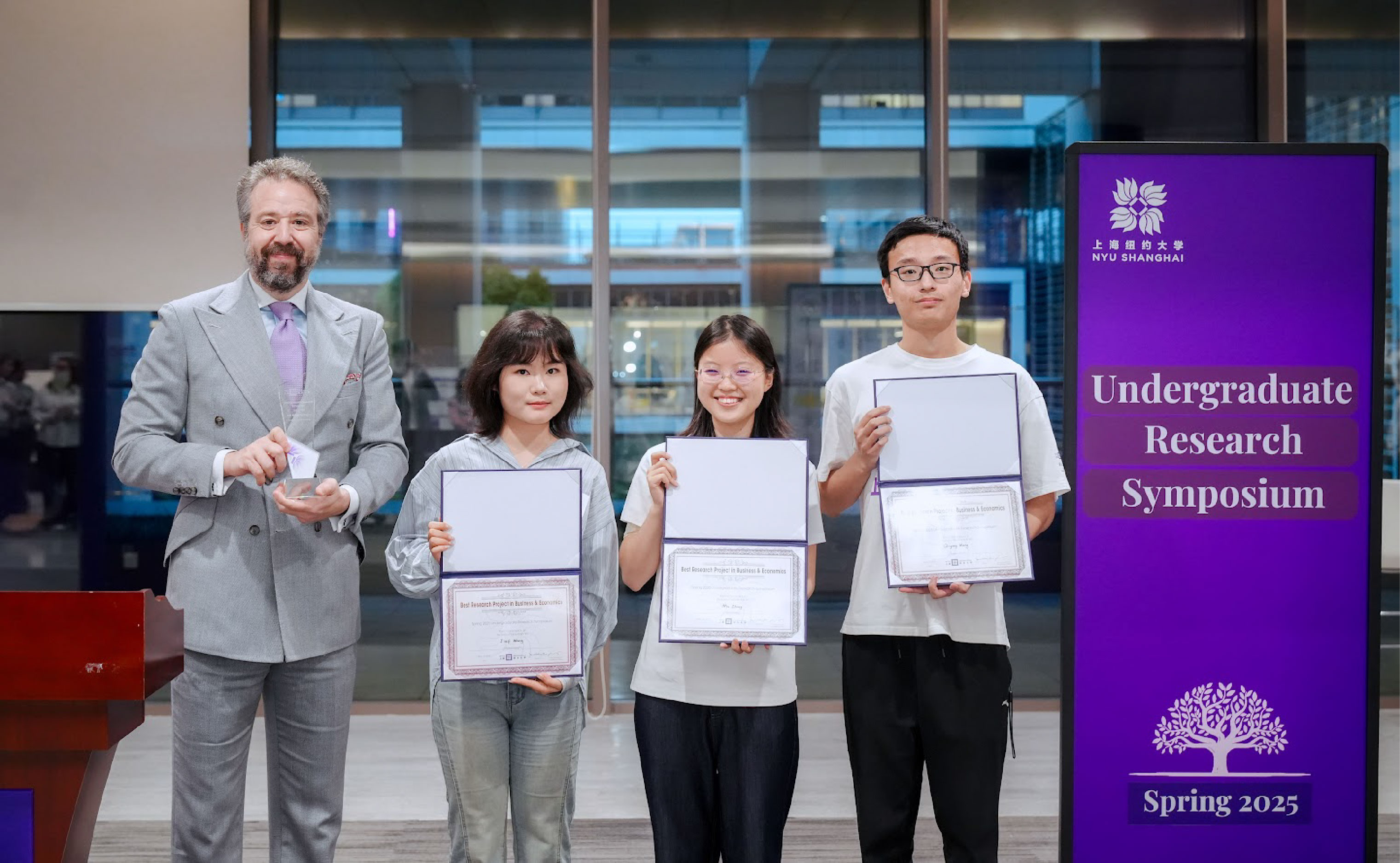
Researchers: Wang Jiaqi, Zhong Mu, and Wang Qiyong
Faculty Mentor: Zhou Xin
Project Abstract: This research investigates whether biodiversity constitutes a priced risk factor in China’s equity market by examining the impact of biodiversity-related news, captured through novel indices built from the People’s Daily, on stock returns. Using NLP and ML techniques, we develop a China-specific biodiversity news index and apply the Fama-French factor model to assess sector-level sensitivities. We further analyze whether firms in high-exposure industries exhibit stronger reactions to environmental news shocks. By filling a critical gap in biodiversity risk quantification, particularly in emerging markets, this research offers practical insights for investors, regulators, and firms integrating environmental risks into financial decision-making.
What was it like working with your mentor?
Zhong Mu: Our research team met weekly to present progress updates, and Prof. Zhou provided thoughtful feedback and clear direction. We also scheduled office hours with Prof. Zhou to discuss specific challenges.He often takes the time to chat with us about our future plans and listens to our thoughts. I appreciate this genuine care about our personal growth.
What challenges did you face and how did you overcome them?
Wang Jiaqi: As someone with a background purely in finance, I was initially unfamiliar with data science techniques. This project required me to step out of my comfort zone and engage deeply with these technical tools. Thankfully, the collaborative nature of our research team allowed me to constantly learn from my peers, engage in frequent discussions, and gradually teach myself the necessary skills.
Another major challenge was the novelty of our research topic — biodiversity finance in China — which remains largely unexplored. There were very few existing studies or datasets we could refer to, making it difficult to validate our hypotheses. We had to embrace uncertainty and be prepared for the possibility of failure in each iteration.
Best Presentation

Researchers: Su Zijin, Zhang Yunhe
Faculty Mentor: Zhou Xin
Project Abstract: This study provides a comprehensive cross-sectional examination of the low-volatility anomaly in China’s A-share market spanning 30 years. We investigate both systematic (beta) and idiosyncratic (IVOL) risk anomalies through univariate and bivariate portfolio analyses. By controlling for lottery-related variables such as MAX, SKEW, and KUR, we assess whether investor preference for lottery-like stocks can explain the anomaly. We confirm the existence of beta and IVOL anomalies in certain time periods. Further, the anomaly’s significance weakens or strengthens after controlling for different lottery proxy variables, highlighting the explanatory power of lottery preferences in the A-share market.
What did you learn from this experience?
Su Zijin: This experience deepened my understanding of the low-volatility anomaly and helped me form a personal methodological framework for research. While the final results often come in a burst, the early stage, filled with complex and sometimes frustrating groundwork, is what truly shapes the outcome. As the Chinese saying goes, "just when you’re about to give up, the light appears." On the presentation side, I learned how to distill our findings into a compelling narrative, using strong visualizations and practicing extensively to ensure clarity and impact."
What challenges did you face and how did you overcome them?
Both: Yes. During the bivariate portfolio analysis, we initially sorted variables in the wrong order, which invalidated part of our results. However, we quickly identified the mistake, held a group discussion, and redistributed tasks efficiently. Since our conceptual framework was already solid, this adjustment was more about correcting execution than revising theory. As a result, we minimized the setback and stayed on track.
Humanities & Social Science
Best Presentation

Researcher: Yu Morui
Faculty Mentor: Brian Hall
Project Abstract: This study evaluated the effectiveness of a hybrid psychological first aid (PFA) training intervention on NYU Shanghai students’ knowledge, attitude, and practice of supporting others and their self efficacy. It was conducted with a formative trial and a main trial, including questionnaires to assess PFA knowledge, PFA skills, self efficacy, psychological distress, and resilience, and interviews to assess PFA practice. The quality of intervention was approved by the formative trial. Main trials and analysis will be conducted soon. This study explored the potential of adopting PFA in universities to promote students’ well-being.
Why did you choose your topic?
My motivation to pilot a Psychological First Aid (PFA) training program on campus stemmed from my passion for supporting others. Through offering peer support to friends and those in need, I became increasingly aware of the widespread mental health challenges among university students, and the meaningful role non-professionals can play. Noticing the lack of peer support initiatives on campus, I proposed this feasibility study to address that gap.
What was it like working with your mentor?
Professor Hall was supportive and insightful throughout the project. He recommended a standardized online PFA training course, which added credibility to the program. He also provided valuable feedback during the formative trial phase, helping make the in-person session more relatable and accessible. His guidance was essential to the successful completion of this project.
What did you learn from this research and presentation experience?
Through this first independent research project, I learned the importance of pilot trials, incorporating feedback, and staying flexible in study design. I was inspired by how non-professionals can effectively support peers after the training, highlighting the power of psychoeducation. The presentation also taught me to engage audiences using clear, accessible language.
STEM
Best Research Project
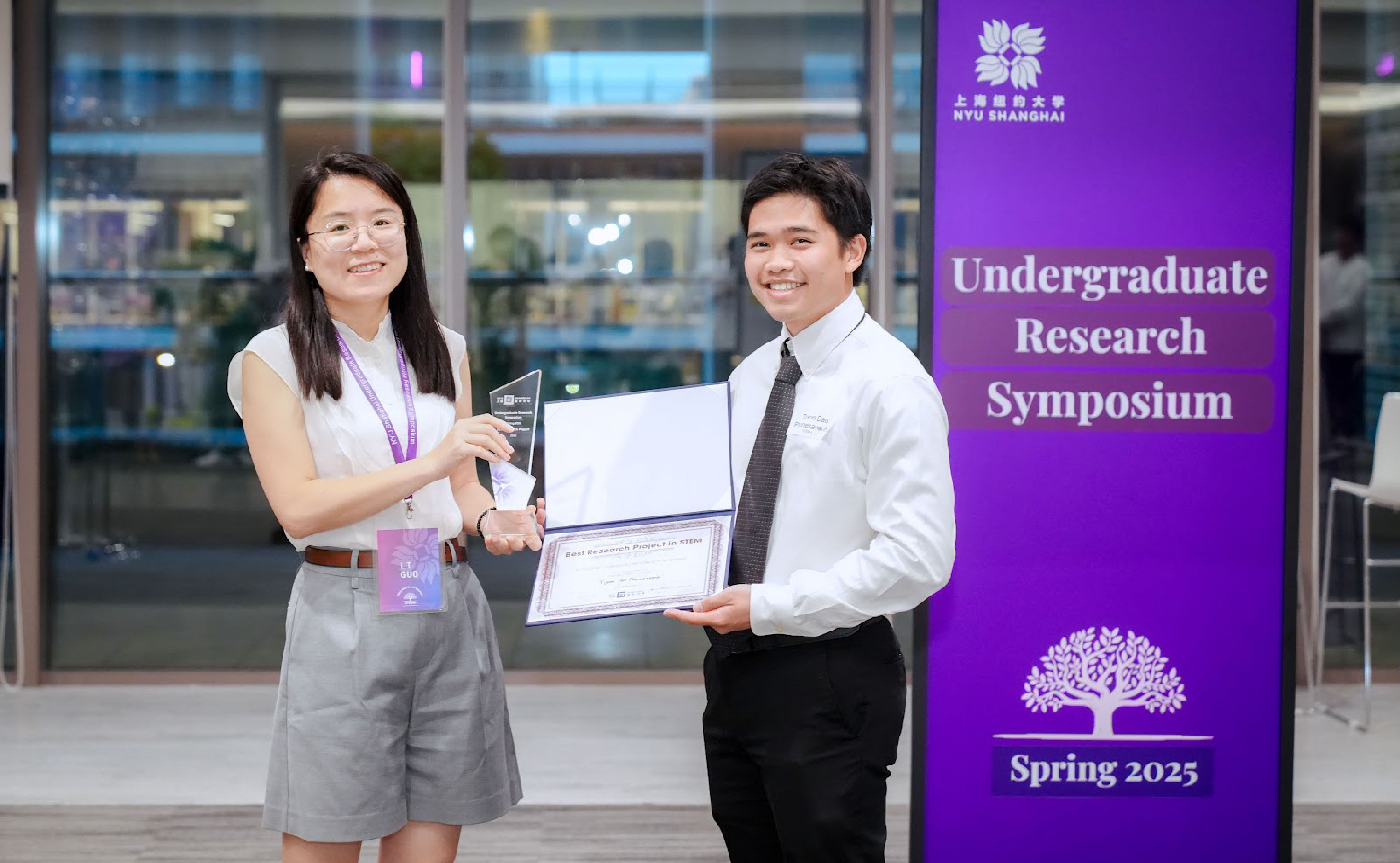
Researcher: Tyson Dao Phonesavanh
Faculty Mentor: Jungseog Kang
Project Abstract: The histone variant H2A.Z is implicated with many functions such as DNA damage repair, mitotic chromosome segregation, centromeric transcription regulation, and more. However, functional differences between H2A.Z isoform variants H2A.Z1 and H2A.Z2 has yet to be thoroughly investigated. In this study, we showed novel, isoform specific association to mitotic kinases Mps1 and AuroraB, mitotic and interphase co-localization to the kinases in vitro, and post translational modifications in response to DNA damage and mitotic arrest. Results indicate non-redundant functions and regulation of the variants that have potential for further investigation.
What was it like working with your mentor?
Regardless of whether my experiments showed my eyes a glaring failure, a blazing success, or even something I couldn’t understand, I credit Professor Jungseog Kang’s insight and encouragement to every success I had. Regardless of how my experiments resulted, the professor made it his priority to develop my skills and mindset in order to become the researcher I am today and will be in the future.
What did you learn from this experience?
Failure is relative. Sometimes failure comes in the form of realizing a silly mistake led to a week's worth of failure. Sometimes it happens as a culmination of efforts. But in the end, it is what we make of the research, what we make of ourselves, and how we carry ourselves as scientists that will be remembered.
Best Presentation
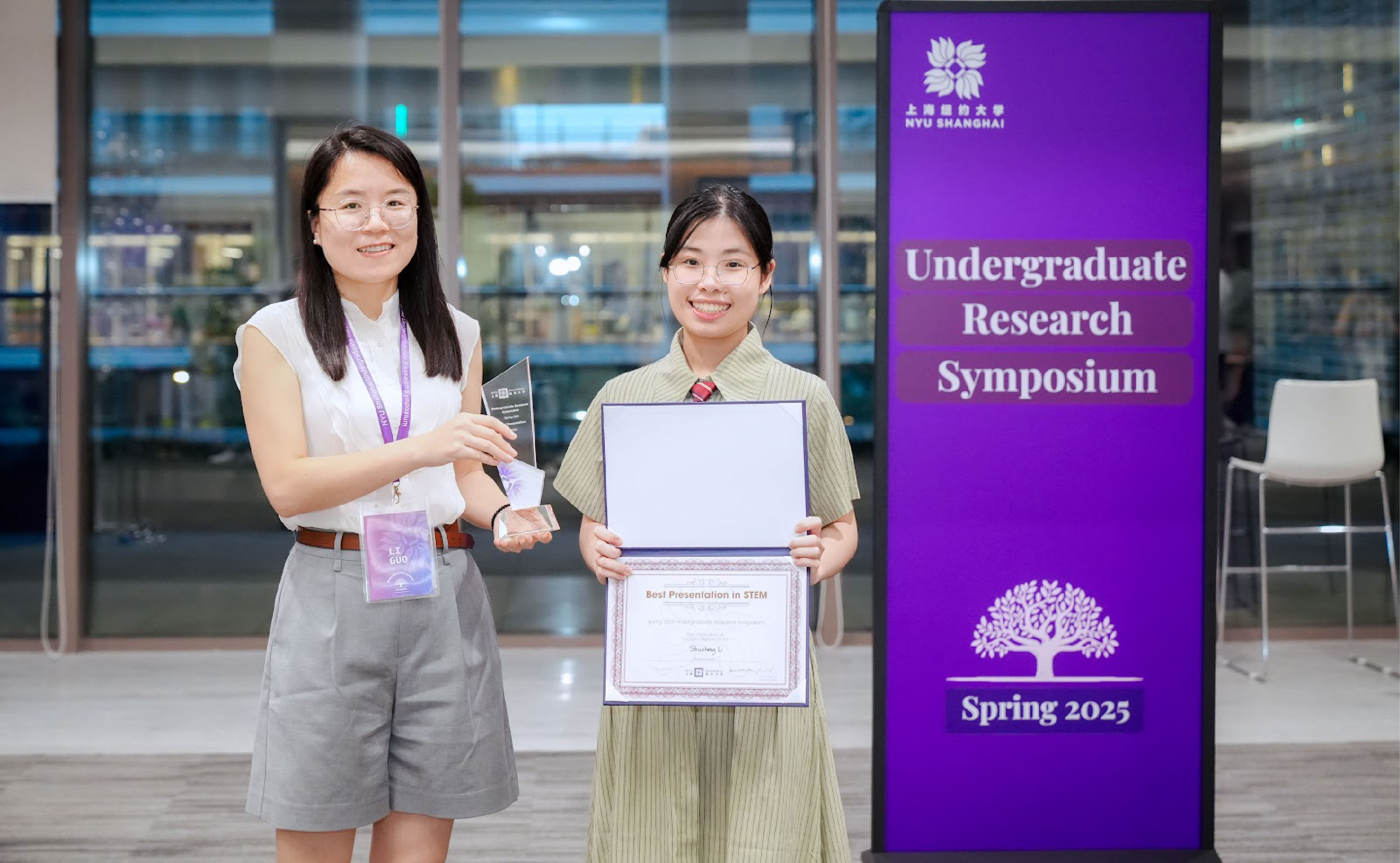
Researcher: Li Shucheng
Faculty Mentor: Tian Xing
Project Abstract: While attention is guided by low-level features like orientation and color and high-level factors such as scene context, task history, and reward, the role of object representations remains unclear. We investigated this using an eye-tracking experiment where Chinese readers searched for a fixed orientation within normal and scrambled Chinese characters, isolating object representation.
Longer reaction and dwell times for scrambled characters suggest that object representations influence attention even in single-feature search. These findings extend Guided Search Theory, demonstrating an interaction between high-level object representations and feature-based guidance, offering new insights into visual attention.
Why did you choose your topic?
I became fascinated with human visual attention during my sophomore year, when I took Professor Xing Tian’s Behavioral and Integrative Neuroscience course. That course really opened my eyes to how selective and strategic attention is — it’s not just about noticing salient or moving things, but also about how the brain prioritizes complex visual input under constraints. After that, I started reading more literature on attention allocation, especially around visual search paradigms. This project let me connect my interest in visual cognition with a concrete gap in the literature, and it gave me a chance to independently develop and test a novel paradigm — which has become a key part of my honors thesis.
What did you learn from this research and presentation experience?
This project was a really important training experience for me as a young researcher. It was the first time I led a study from the ground up, starting with identifying the research question, designing the experimental paradigm, and seeing it through data collection and analysis. It helped me learn how to think critically about research design and how to translate a theoretical question into something testable.
I collaborated closely with my partner Jieyu. We supported each other throughout the process, and a lot of our progress came from talking through the logic of the design together and with our mentor. That kind of collaborative thinking really helped us clarify both the theoretical motivation and the experimental details. In the end, navigating these challenges made the project much stronger and taught me how to deal with uncertainty in research, which I think is a core part of doing science.
Most Popular Project
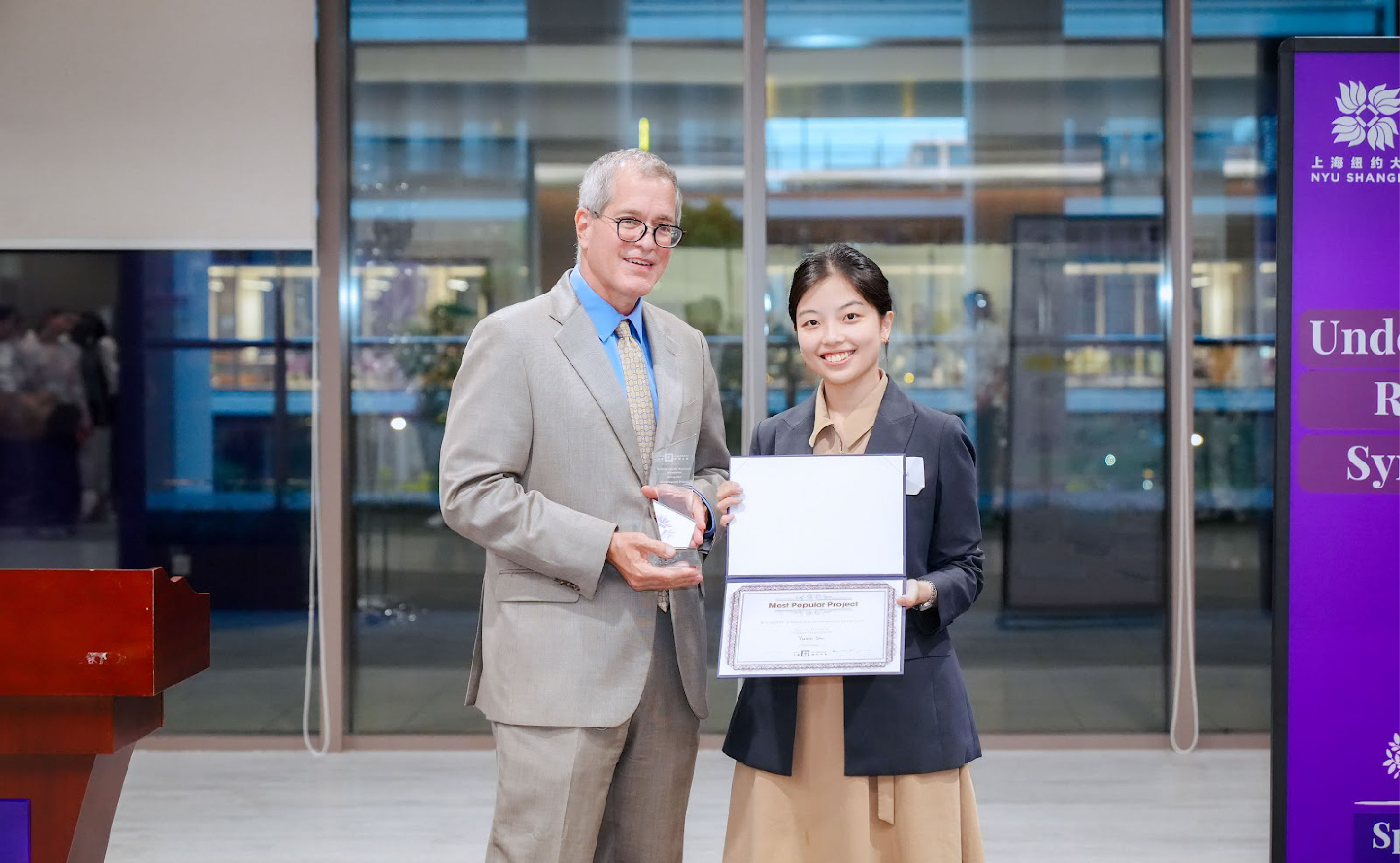
Researcher: Lizzy Shi Yuxin
Faculty Mentor: Zhou Xin
Project Abstract: This study examines the impact of the Monitoring, Reporting, and Verification (MRV) process on price volatility and trading activity in China’s national carbon emissions trading market. Using monthly data from eight regional markets (2013–2023), we apply fixed-effects regression and event study methodology to assess whether market participants respond to MRV reporting periods. Findings show that while MRV periods significantly increase trading volume, they have limited influence on price levels and returns. The results underscore the importance of improving MRV transparency to enhance market efficiency, offering regulatory insights into how compliance mechanisms shape behavior in emerging carbon markets.
What was it like working with your mentor?
Working with Professor Zhou has been both rigorous and deeply inspiring. He introduced me to the development of China's national carbon market. His explanation sparked my curiosity. Every Friday, our RA team at the Volatility Institute not only attends group meetings where we present progress and receive detailed feedback, but we also submit our weekly research reports and updated drafts of our working papers. This structure kept me accountable and helped me build strong habits in academic writing and project planning. Professor Zhou always offered insightful, constructive advice, not just on methodology, but also on how to position our work in the broader literature and policy context.
What aspect of the research were you most surprised about?
One of the most surprising and rewarding parts of this experience was presenting my work at the Undergraduate Research Symposium. I was genuinely surprised by how many people were interested in carbon markets and MRV, even those from non-economics backgrounds. Some professors and students stayed for quite a while just to discuss the implications of my results, and several told me they were impressed by the clarity and depth of the work. That was an incredible feeling.


